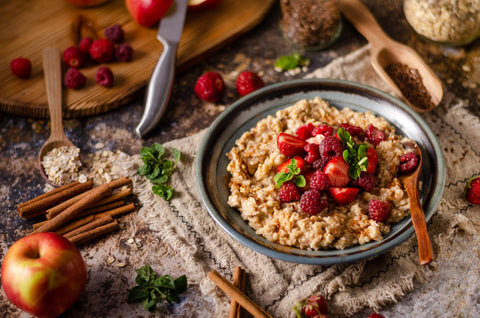Sorbitol in Food: The Sugar Alternative with a Sensitive Side
You may already know that sorbitol is in your favourite chewing gum, but did you know there is sorbitol in food? Sorbitol is a type of sugar alcohol that can be beneficial if you're watching your sugar intake. However, it can cause havoc for those with sensitive tummies if consumed in large enough quantities. So, if you want to learn more about sorbitol in food, sorbitol as an artificial sweetener and the interesting pros and cons of this sugar alternative, read on!
What is Sorbitol?
Sorbitol is a hexahydric alcohol (sugar alcohol) that appears as a white crystalline powder. It’s hygroscopic (absorbs moisture) and about half as sweet as table sugar. Sorbitol is commonly used in sweet drinks, confectionary and chewing gum.
Sorbitol belongs to the family of polyols alongside mannitol and is categorised as a Fermentable Oligosaccharide, Disaccharide, Monosaccharide, and Polyol (FODMAP) substance. Sorbitol will appear on food labels as additive E420 and is also naturally found in some fruits and vegetables.
Sorbitol acts as a carbohydrate in the body, although many people poorly digest it. In small amounts, sorbitol appears in the fibres of many vegetables and fruits, but it can also be synthesised from glucose. It's marketed as a diabetic-friendly and low-calorie sugar substitute and is added to mints, gums and lollies for its non-nutritive benefits. When consumed, Sorbitol has a distinctive cooling effect, making it a common additive in toothpaste, mint-flavoured gums and confectionery.

What Foods Contain Sorbitol?
There are varying degrees of sorbitol in food. If you're following a low-FODMAP diet, knowing which foods contain sorbitol minimises the risk of digestive symptoms, gas and bloating.
Here's a list of foods that naturally contain sorbitol:
- Apples
- Apricots
- Avocados
- Blackberries
- Cherries
- Dates
- Figs
- Dried fruits
- Lychees
- Nectarines
- Peaches
- Pears
- Plums
- Prunes
- Raisins
- Raspberries
- Strawberries
- Sultanas
- Sweet corn
- White cabbage
Sorbitol in Food: Health Pros and Cons
There are a couple of benefits to sorbitol and some uncomfortable side effects. On one hand, sorbitol may be a solid choice as a substitute for sugar for people with diabetes. Sugar alcohols like xylitol, mannitol and sorbitol are also beneficial to dental health. Let's take a look at these pros of sorbitol in detail below.
Sorbitol Benefits
Doesn't Impact Blood Sugar
If you're a diabetic or just conscious of monitoring your overall sugar intake, consuming diet foods that contain sorbitol sounds like a winning approach. The idea is that you can indulge in sweet treats without the calorie load and blood-sugar derailment that comes with them. On the face of it, sorbitol is a generally safe alternative to table sugar, as it is absorbed slowly into the bloodstream, preventing rapid spikes in blood glucose. In small amounts, sorbitol could be an appropriate sugar alternative for people who struggle to metabolise glucose appropriately.
Promotes Oral Health
Sugar alcohols, like sorbitol, may help prevent cavities in a few different ways. One obvious mechanism is that sorbitol consumption in confectionary may displace excess glucose consumption. Ideally, this means that if you're a fan of sweets and tend to consume them frequently, you may be better off enjoying those sweetened with sorbitol instead of sugar to avoid dental caries and decay. Another consideration is that the act of chewing gum or confectionery helps stimulate saliva production, which has protective benefits for oral health.
Sorbitol Side Effects
It’s not all sweet and rosy in the world of sorbitol. There are also some significant side effects to consider when consuming this polyol, whether from natural sources or synthetically. Let’s dive into the cons of sorbitol below.
Impairs Glucose Tolerance
In a paradoxical finding, recent research from the journal Life Sciences established that four weeks of sorbitol consumption in mice decreased glucose metabolism and uptake. Medium to long-term sorbitol intake disrupts the microbiome and has detrimental downstream impacts on glucose function. It's important to remember that this study doesn’t reflect the usual consumption of sorbitol in food, as it appears in nature. As such, it’s likely that chronic sorbitol consumption in concentrated forms (as may occur in gum and treats) could cause these metabolic disruptions.
Causes Digestive Upset
Digestive complaints are commonly reported by people consuming products or foods high in sorbitol. Sorbitol is classified as a FODMAP, specifically falling under the category of polyols. When ingested, sorbitol moves through the digestive tract and is absorbed by passive diffusion in the small intestine. However, in most people, sorbitol is only partially digested and, in high amounts, acts as a natural laxative as it draws water into the large intestine.
Suppose a carbohydrate substrate is only partially digested or absorbed in the gut. In that case, local gut bacteria are present to break it down further, which causes fermentation and gas buildup. This phenomenon, coupled with the water increase in the large bowel, contributes to the onset of some very uncomfortable gastrointestinal symptoms.
Some common symptoms related to excess sorbitol consumption may include:
- Gas
- Bloating
- Abdominal distension
- Flatulence
- Local abdominal pain
- Diarrhoea
- Dehydration
The research on the negative impacts of sorbitol in food is variable, with a range of 5-20 g per day being enough to cause digestive upset. Liauw and Saibil (2019) indicate that sorbitol can cause intestinal symptoms, such as those mentioned above, at levels exceeding 20 g per day.
Remember, each person's sensitivity to sorbitol in food or sorbitol from other sources will vary greatly. Some people may not experience any adverse effects, while others may be more at risk of developing negative digestive symptoms from consuming even minimal amounts of sorbitol. In fact, studies show that over 30% of adults may not tolerate 10 g of sorbitol daily consumption.

Low-Sorbitol Meal Ideas
Here are some meal ideas using low-sorbitol foods that are both delicious and gentle on the digestive system:
- Oatmeal with Chia Seeds and Maple Syrup: Cook oats with water or lactose-free milk, then top with chia seeds and a drizzle of maple syrup.
- Low FODMAP Smoothie: Blend bananas, strawberries, lactose-free yogurt, and a splash of almond milk for a refreshing start to your day.
- Rice Cakes with Peanut Butter: Spread a thin layer of peanut butter on a rice cake and top with banana slices.
- Carrot and Cucumber Sticks with Hummus: Dip freshly cut carrot and cucumber sticks in a small serving of hummus.
- Quinoa Salad with Grilled Chicken: Toss cooked quinoa with grilled chicken pieces, cucumbers, carrots, and a lemon-olive oil dressing.
- Turkey and Swiss Cheese Wrap: Use a gluten-free wrap filled with turkey, Swiss cheese, grated carrots, lettuce, and mustard.
- Beef Stir-Fry with Ginger and Broccoli: Stir-fry beef slices with ginger, broccoli, and bell peppers in a low-sodium soy sauce. Serve over a bed of rice.
- Pasta Primavera with Garlic-Infused Olive Oil: Use gluten-free pasta and toss it with garlic-infused olive oil, zucchini, spring peas, and Parmesan cheese.
Take Care When Consuming Sorbitol in Food
Given the potential digestive issues associated with excessive sorbitol consumption, it's wise to monitor your intake - both from sorbitol in foods and sweets or chewing gum. Here are a few tips for navigating sorbitol in your diet:
- Read Labels Carefully: Familiarise yourself with food labels to identify products containing sorbitol (E420) and gauge their quantity in your diet.
- Listen to Your Body: Pay attention to how your body reacts to products or foods containing sorbitol. If you experience discomfort, consider reducing your intake or cutting out these products altogether and see how you feel.
- Consult with a Health Professional: If you have underlying health conditions or concerns about including sorbitol in your diet, seeking advice from a healthcare provider or dietitian is always wise.
Sorbitol in Food: A Balanced Perspective
While sorbitol serves as a useful sugar substitute in various foods and products, consuming it with caution is important. This is especially true if you have a sensitive tummy or suspect a FODMAP intolerance. Knowing your body and its response to sorbitol in food can be helpful if you've been struggling with digestive issues. It’s possible to enjoy the benefits of sorbitol-containing products in moderation, maintaining a balanced and healthful diet. If in doubt, make sure you read food labels and seek professional help when necessary.
Recipe
Savoury Spinach and Feta Muffins
These savoury muffins are a fantastic low-sorbitol and low-FODMAP breakfast option. They're perfect for meal prep and can be enjoyed on the go, making your mornings easier and more delicious.
Ingredients
- 6 large eggs
- 1/2 cup lactose-free milk (or almond milk for a dairy-free option)
- 1 cup fresh spinach, roughly chopped
- 1/2 cup crumbled feta cheese (ensure it's low lactose if necessary)
- 1/4 cup diced red capsicum (green capsicum is also a low FODMAP option)
- Salt and pepper, to taste
- Non-stick cooking spray or olive oil for greasing
Method
- Preheat your oven to 190°C. Grease a 12-cup muffin tin with non-stick cooking spray or a bit of olive oil.
- In a large mixing bowl, whisk together the eggs and lactose-free milk until well combined. Season with a pinch of salt and pepper.
- Stir in the chopped spinach, crumbled feta cheese, and diced bell pepper until evenly distributed throughout the mixture.
- Carefully pour the egg mixture into the prepared muffin tin, filling each cup about 3/4 full.
- Place the muffin tin in the preheated oven and bake for 20-25 minutes, or until the egg muffins are set and lightly golden on top.
- Allow the egg muffins to cool in the pan for a few minutes before removing them. Serve warm or let them cool completely and store in the refrigerator for an easy grab-and-go breakfast during the week.
Storage Tip:
These egg muffins can be stored in an airtight container in the refrigerator for up to 4 days. To reheat, simply microwave for 30-60 seconds until heated through.
Article References
Desai C. (2016). Meyler's side effects of drugs: The international encyclopedia of adverse drug reactions and interactions. Indian Journal of Pharmacology, 48(2), 224.
Liauw, S., & Saibil, F. (2019). Sorbitol: Often forgotten cause of osmotic diarrhea. Canadian family physician Medecin de famille canadien, 65(8), 557–558.
Li, C. H., Wang, C. T., Lin, Y. J., Kuo, H. Y., Wu, J. S., Hong, T. C., Chang, C. J., & Wu, H. T. (2022). Long-term consumption of the sugar substitute sorbitol alters gut microbiome and induces glucose intolerance in mice. Life sciences, 305, 120770. https://doi.org/10.1016/j.lfs.2022.120770
Food Standards Australia New Zealand (FSANZ). (2019, May). Food additives - numerical. https://www.foodstandards.gov.au/sites/default/files/consumer/additives/additiveoverview/Documents/Food%20additives%20-%20numberical%20May%202019.pdf, viewed 1 April 2024
Monash University, FODMAP foods, Polyols, https://www.monashfodmap.com/blog/what-are-polyols, viewed 1 April 2024
Sciencedirect.com. (n.d.). Sorbitol. Retrieved from https://www.sciencedirect.com/topics/agricultural-and-biological-sciences/sorbitol, viewed 1 April 2024
Wikipedia, Wikipedia Contributors. (2024, April 1). Sorbitol. Retrieved from https://en.wikipedia.org/wiki/Sorbitol

